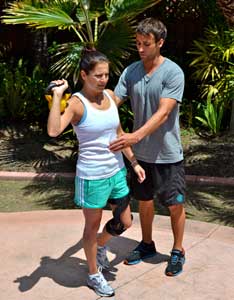We’re all familiar with the quintessential late night P90x or Insanity infomercials, you know the one with the over-caffeinated trainer sprinting around in circles doing jumping jacks and push ups until his head explodes? Or maybe you’ve even tried out one of these “high intensity, interval training” workouts. Don’t get me wrong, interval training is an effective way to strengthen the cardiovascular system and increase your aerobic capacity. However, the average person who decides they’re literally going to “jump” right into one of these “get ripped quick” exercise challenges will most likely be sidelined with an injury within a few weeks, or completely turned off by the whole experience.
It’s undeniable, most of us have some type of muscle imbalance or weakness. The majority of people who are seated at work daily might be experiencing low back pain, forward rounded shoulders, and tight hamstrings. This seated posture over a long period of time allows muscles to become shortened and weak, which is the root cause of the aforementioned symptoms. Don’t worry, there is light at the end of the tunnel, and you don’t have to overtrain your body to achieve the foundation you need to get back in the exercise game.
Before ambitiously starting an “As seen on TV” workout plan, it may be wise to seek professional advice first. Completing a proper fitness assessment will identify any precursors to injury such as muscle imbalances, tightness, or limited range of motion that might stem from past injuries or improper posture. By ignoring these limitations, you are likely to perform exercises with incorrect form which may lead to higher risk of injury.
It may not be quite as gratifying as the “get ripped in 60 or 90 days” plan, but corrective exercise can provide longevity not only to your mind and body, but also to your new active lifestyle.
You may be asking yourself what is corrective exercise? Corrective exercise is not a “one size fits all” routine. Based on the results from your initial fitness assessment, most personal trainers will develop an exercise plan tailored to your needs and goals, with attention to any limitations that need to be accounted for before doing specific exercises or movement. Through corrective exercise, you will take the necessary steps to strengthen these problem areas, which in turn will provide you with a stronger foundation for success. Most exercises that fall in the corrective category are:
-
Intermediate
- Low impact
-
Closed chain
-
Low intensity
-
Core strengthening
-
Focused on stretching
If you’d like to get some fresh air and avoid staring mindlessly at a television while you workout, you can schedule your Initial Fitness Assessment with one of our qualified personal trainers by applying here: http://www.allabilitiespt.com/get-started/

